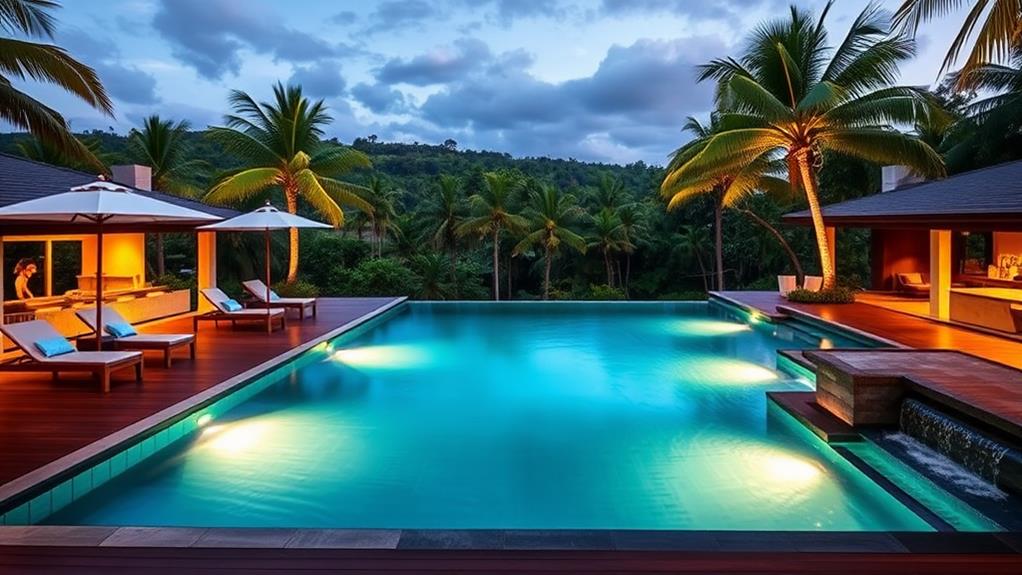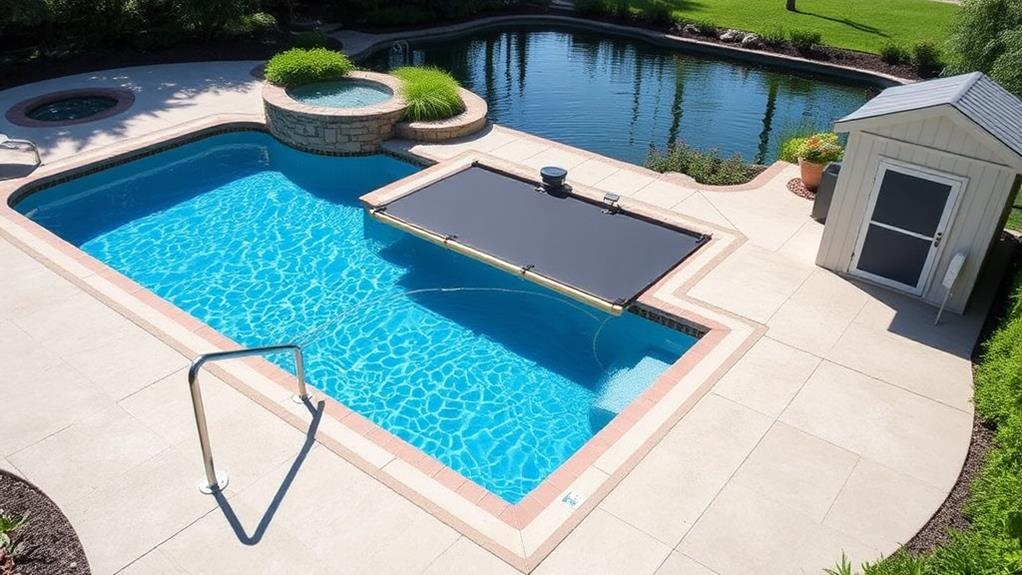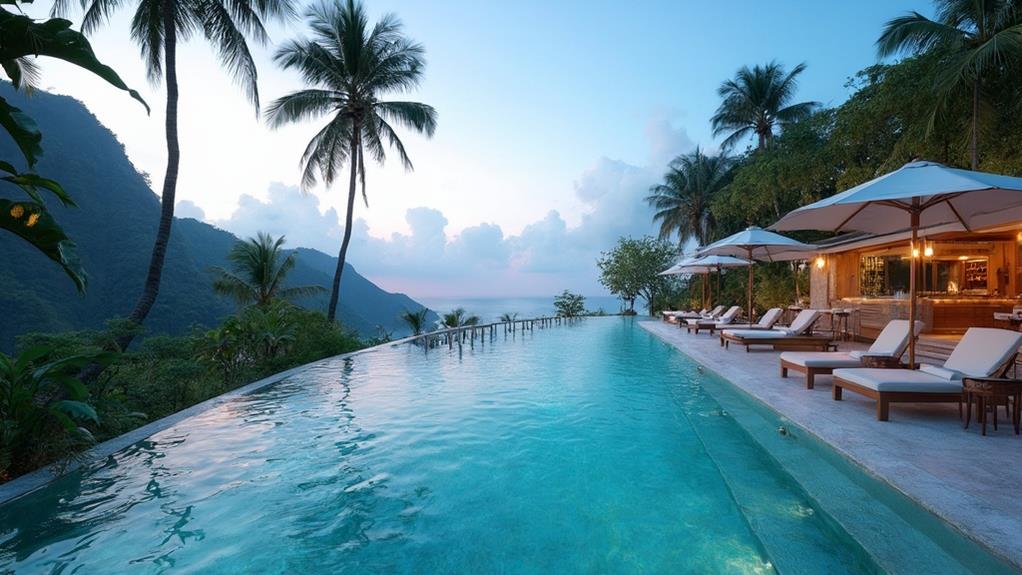Creating the ultimate aquatic retreat involves thoughtful design, material selection, and landscaping. Consider your pool's shape, size, and intended use while integrating it seamlessly with the surroundings. Choose durable, low-maintenance materials for the pool interior, coping, and decking. Enhance the ambiance with strategic landscaping, incorporating native plants and water features. Add essential amenities like comfortable seating, shade structures, and convenience features. Don't forget to prioritize safety and maintenance aspects, including proper fencing, non-slip surfaces, and efficient filtration systems. By carefully considering these elements, you'll be well on your way to achieving poolside perfection. The following sections will guide you through each aspect of your aquatic oasis transformation.
Design Considerations for Your Oasis

When planning your aquatic retreat, careful consideration of design elements is crucial to create a harmonious and functional space. Begin by assessing your available area and determining the optimal pool shape and size that complement your property's layout. Consider the intended use of the pool, whether for lap swimming, family recreation, or entertaining, to guide your design choices.
Integrate the pool seamlessly with its surroundings by selecting materials and colors that blend with your home's architecture and landscape. Incorporate ample decking space for lounging and socializing, using non-slip materials for safety. Plan for proper lighting to enhance ambiance and extend usability into the evening hours.
Think about privacy and wind protection, incorporating natural elements like strategically placed plants or architectural features such as pergolas or screens. Consider the placement of amenities like outdoor showers, storage areas, and equipment housing to maintain a clean, uncluttered look. Don't forget practical elements such as easy access points, stairs, and handrails for safety and convenience. By carefully addressing these design considerations, you'll create a cohesive and inviting aquatic retreat that enhances your property and lifestyle.
Selecting the Perfect Pool Materials
Choosing the right materials for your pool is a critical step in creating a durable, attractive, and low-maintenance aquatic retreat. The primary materials to consider are the pool's interior finish, coping, and decking.
For the pool's interior, options include plaster, aggregate, and tile. Traditional white plaster is cost-effective but may require more frequent resurfacing. Quartz or pebble aggregate finishes offer enhanced durability and unique textures. Glass or porcelain tile provides a luxurious look and exceptional longevity, albeit at a higher cost.
Coping, the material that caps the pool wall, should complement both the pool interior and surrounding landscape. Natural stone, such as travertine or slate, offers a classic look, while precast concrete provides versatility in color and shape.
Decking materials must be slip-resistant and able to withstand constant exposure to water and chemicals. Popular choices include textured concrete, pavers, natural stone, and composite decking. Each option varies in terms of heat retention, maintenance requirements, and aesthetics.
When selecting materials, consider factors such as climate, usage patterns, and overall design aesthetic to ensure your pool not only looks stunning but also stands the test of time.
Landscaping for Poolside Ambiance

Ambiance plays a crucial role in transforming a pool area into a true aquatic retreat. Effective landscaping can create a serene and inviting atmosphere, enhancing the overall pool experience. When planning your poolside landscape, consider incorporating a mix of native plants and tropical species that thrive in your climate. Lush greenery, such as palm trees, ferns, and ornamental grasses, can provide privacy and a natural backdrop.
Incorporate hardscaping elements like stone pathways, retaining walls, or a rock garden to add texture and visual interest. Strategic lighting is essential for creating a magical ambiance during evening hours. Install underwater pool lights, pathway illumination, and accent lighting for trees and architectural features. Consider adding water features like fountains or cascades to introduce soothing sounds and visual appeal.
Create designated zones for relaxation, dining, and socializing by using different flooring materials or arranging outdoor furniture. Introduce shade elements like pergolas, cabanas, or large umbrellas to provide comfort on hot days. Finally, choose low-maintenance plants and materials to ensure your poolside oasis remains beautiful with minimal upkeep, allowing you to fully enjoy your aquatic retreat.
Essential Amenities and Accessories
A well-appointed pool area requires several essential amenities and accessories to enhance comfort, safety, and enjoyment. Comfortable seating options are crucial, including lounge chairs, outdoor sofas, and dining sets for poolside relaxation and entertainment. Umbrellas or shade structures provide necessary protection from the sun, while outdoor lighting extends usability into the evening hours.
Safety features are paramount, including secure fencing, non-slip decking, and proper drainage systems. A pool cover helps maintain cleanliness and temperature when the pool is not in use. For convenience, consider installing outdoor storage units to house pool toys, cleaning equipment, and towels.
To elevate the experience, incorporate amenities such as an outdoor shower, a changing area, and a beverage station or outdoor kitchen. Pool accessories like floating loungers, pool noodles, and games add fun and versatility. For year-round use, a pool heater extends the swimming season, while an automated cleaning system reduces maintenance efforts.
Lastly, don't overlook the importance of proper pool chemistry equipment and a first-aid kit to ensure a safe and hygienic environment for all users.
Maintenance and Safety Features

To ensure a safe and enjoyable aquatic retreat, implementing proper maintenance routines and safety features is crucial. Regular cleaning and chemical balancing are essential to prevent algae growth and maintain water quality. Install an efficient filtration system and automated pool cleaner to reduce manual labor. Incorporate a pool cover to minimize debris accumulation and improve energy efficiency.
Safety should be a top priority. Install proper fencing with self-latching gates to prevent unauthorized access. Non-slip decking materials around the pool area reduce the risk of accidents. Adequate lighting enhances visibility during evening swims and improves overall ambiance. Install depth markers and clearly visible safety signage to remind users of pool rules and potential hazards.
Invest in safety equipment such as life rings, rescue poles, and first aid kits, keeping them easily accessible. Consider installing pool alarms that detect unexpected water movement. For families with young children, adding a shallow wading area or steps with handrails can provide a safer entry point. Regular inspections of pool equipment, including pumps, drains, and electrical systems, ensure optimal performance and identify potential safety issues before they become problematic.
Frequently Asked Questions
How Long Does a Typical Pool Renovation Project Take to Complete?
A typical pool renovation project duration varies depending on the scope of work. Simple resurfacing may take 1-2 weeks, while extensive renovations involving structural changes, new equipment, and landscaping can extend to 4-8 weeks or longer.
What Are the Average Costs Associated With Renovating an Existing Pool?
Pool renovation costs can skyrocket into the stratosphere! On average, homeowners invest between $5,000 and $15,000 for basic updates. More extensive renovations, including structural changes or high-end features, can easily surpass $30,000, depending on the project's scope.
Are There Eco-Friendly Options for Pool Heating and Water Treatment?
Yes, eco-friendly options exist for pool heating and water treatment. Solar heating systems, heat pumps, and geothermal systems offer energy-efficient heating alternatives. For water treatment, saltwater chlorination, UV systems, and ozone generators provide environmentally conscious solutions to maintain pool cleanliness.
Can I Convert My Traditional Pool Into a Natural Swimming Pond?
Ah, yes, because nothing says "back to nature" like bulldozing your backyard! Converting a traditional pool to a natural swimming pond is possible, requiring extensive redesign, filtration systems, and the addition of aquatic plants for purification.
How Do Local Zoning Laws and HOA Regulations Affect Pool Renovation Projects?
Local zoning laws and HOA regulations can significantly impact pool renovation projects. They may dictate setback requirements, depth restrictions, fencing regulations, and permitting processes. Always check with local authorities and your HOA before starting any pool renovation work.
Conclusion
In the tapestry of aquatic renovation, each element weaves together to form a harmonious oasis. Like a skilled conductor orchestrating a symphony, the designer balances form and function, materials and aesthetics. The resulting poolside retreat becomes a microcosm of paradise, where carefully chosen flora and thoughtful amenities create an atmosphere of tranquility. As with any delicate ecosystem, maintenance and safety measures ensure this aquatic haven continues to flourish, offering a sanctuary from the cacophony of daily life.

